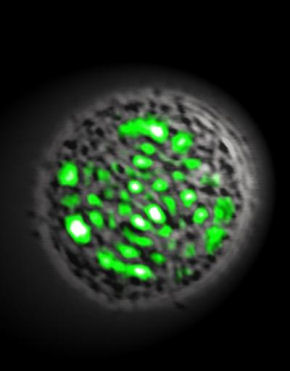14 June 2011
Living cell turned into a laser
by Kate Melville
 Researchers at Massachusetts General Hospital have genetically engineered a single cell to express green fluorescent protein that can be used to amplify photons into pulses of laser light.
Researchers at Massachusetts General Hospital have genetically engineered a single cell to express green fluorescent protein that can be used to amplify photons into pulses of laser light.
Developed some 50 years ago, lasers have traditionally used synthetic materials such as crystals, dyes and purified gases to amplify photons as they bounce back and forth between two mirrors. Appearing in Bature Photonics, this is the first report of a successful biological laser based on a single, living cell.
"Part of the motivation of this project was basic scientific curiosity. In addition to realizing that biological substances had not played a major role in lasers, we wondered whether there was a fundamental reason why laser light, as far as we know, does not occur in nature or if we could find a way to achieve lasing in biological substances or living organisms," explained researcher Malte Gather. Green fluorescent protein (GFP) - originally found in a species of jellyfish - can be induced to emit light without the application of additional enzymes. Its properties are well understood, and there are established techniques to genetically program many organisms to express GFP.
To assess the protein's potential for generating laser light, the researcher assembled a device consisting of an inch-long cylinder, with mirrors at each end, filled with a solution of GFP in water. After first confirming that the GFP solution could amplify input energy into brief pulses of laser light, the researchers estimated the concentration of GFP needed to produce the laser effect.
Using that information, their next step was to develop a line of mammalian cells expressing GFP at the required levels. The cellular laser was assembled by placing a single GFP-expressing cell in a microcavity consisting of two highly reflective mirrors spaced 20 millionths of a meter apart. Not only did the cell-based device produce pulses of laser light, the researchers also found that the spherical shape of the cell itself acted as a lens, refocusing the light and inducing emission of laser light at lower energy levels than required for the solution-based device. The cells used in the device survived the lasing process and were able to continue producing hundreds of pulses of laser light.
"While the individual laser pulses last for only a few nanoseconds, they are bright enough to be readily detected and appear to carry very useful information that may give us new ways to analyze the properties of large numbers of cells almost instantaneously," said co-researcher Seok Hyun Yun. "And the ability to generate laser light from a biocompatible source placed inside a patient could be useful for photodynamic therapies, in which drugs are activated by the application of light, or novel forms of imaging."
Gather and Yun are also interested in finding ways to bring optical communications and computing into the realm of biotechnology; a union that would be particularly useful for the interfacing of electronics with biological organisms.
Related:
Electronic components made from human blood
International team claim organic computing breakthrough
Laser spark plug to give gas guzzlers new lease on life
Nanotronics within reach with creation of molecule-sized diode
Source: Massachusetts General Hospital
